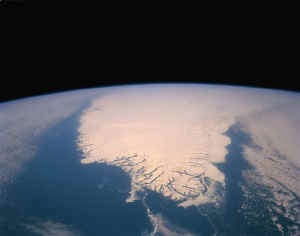
STS045-152-105, 29 March 1992: The southern tip of Greenland
is seen in this high-oblique, almost colorless, stark photograph
of the world’s largest island. The blackness of space contrasts
sharply with the whiteness of clouds, ice, and snow. The only true
color is the blue of the Atlantic Ocean and the Labrador Sea.
Cloud-free conditions existing along the southern coastal area
emphasize the deeply indented fjords along the coast. A close look
at the white areas reveals three different features-snow and ice
on the land; cloud formations over the central region and the
eastern and western sides of the island; and wispy-looking ice
floes off the southeast and the southwest tip of the fjord-lined
coast, which are moved by the East Greenland Current to the
south-southwest, and larger ice packs developing north along the
east coast. Greenland has the only surviving continental glacier
in the Northern Hemisphere. This ice sheet covers seven-eighths of
Greenland’s surface and contains an estimated 11 percent of the
world’s fresh water.
| On March 14, 2010 the Eastern Native Tree
Society and Western Native Tree Society switched from
discussion lists on Google Groups to a new discussion
list in a Bulletin Board format at:
http://www.ents-bbs.org/index.php
Posts made since the inception of the BBS on March 14,
2010 will be sorted and archived on the BBS. Click on
the link to go to the equivalent section on the new BBS.
This website will continue to serve as a front end for
the ENTS and WNTS groups. It will continue to serve as a
repository of older posts, and will serve as the host
site for special projects and features that are not well
suited for a BBS format. Please visit the BBS for the
latest information and trip reports. |
 Greenland
Greenland
- Greenland Vegetation http://www.randburg.com/gr/general/general_10.html
Greenland lies north of the tree line and with rare exceptions it is not possible to cultivate crops...Forest-like brush exists in many places. The sunniest valleys in South Greenland have stands of strong, upright birch trees which attain a height of up to 7 metres. Greenlandic ash and various species of willow, evergreens, ferns and several species of herbs also grow in South Greenland. Greenland has a highly varied flora growing on its mountain-slopes, marshes and meadows.
- Greenland Geographia http://www.geographia.com/denmark/greenland.html
Greenland is the largest island in the world. Its northerly location, at the point where the Atlantic meets the Arctic Ocean, means that Greenland is surrounded principally by cold ocean currents, so the coasts are constantly being cooled. This, combined with the radiation of cold from the inland ice, gives Greenland its arctic climate.
The ice cap or inland ice covers 1,833,900 square km, equivalent to 85 percent of Greenland's total area, and extends 2,500 km (1,553 miles) from north to south and up to 1,000 km from east to west.
- East Greenland Arctic Vegetation http://www.eastgreenland.com/database.asp?lang=eng&num=235
- Greenland and the Faeroe Islands http://www.um.dk/Publikationer/UM/English/Denmark/kap7/7-1.asp
Southwest Greenland is characterized by dense vegetation which
can develop into thicket and woodland in sheltered areas.
Generally, however, the island is devoid of trees and covered
by sparse vegetation.
|